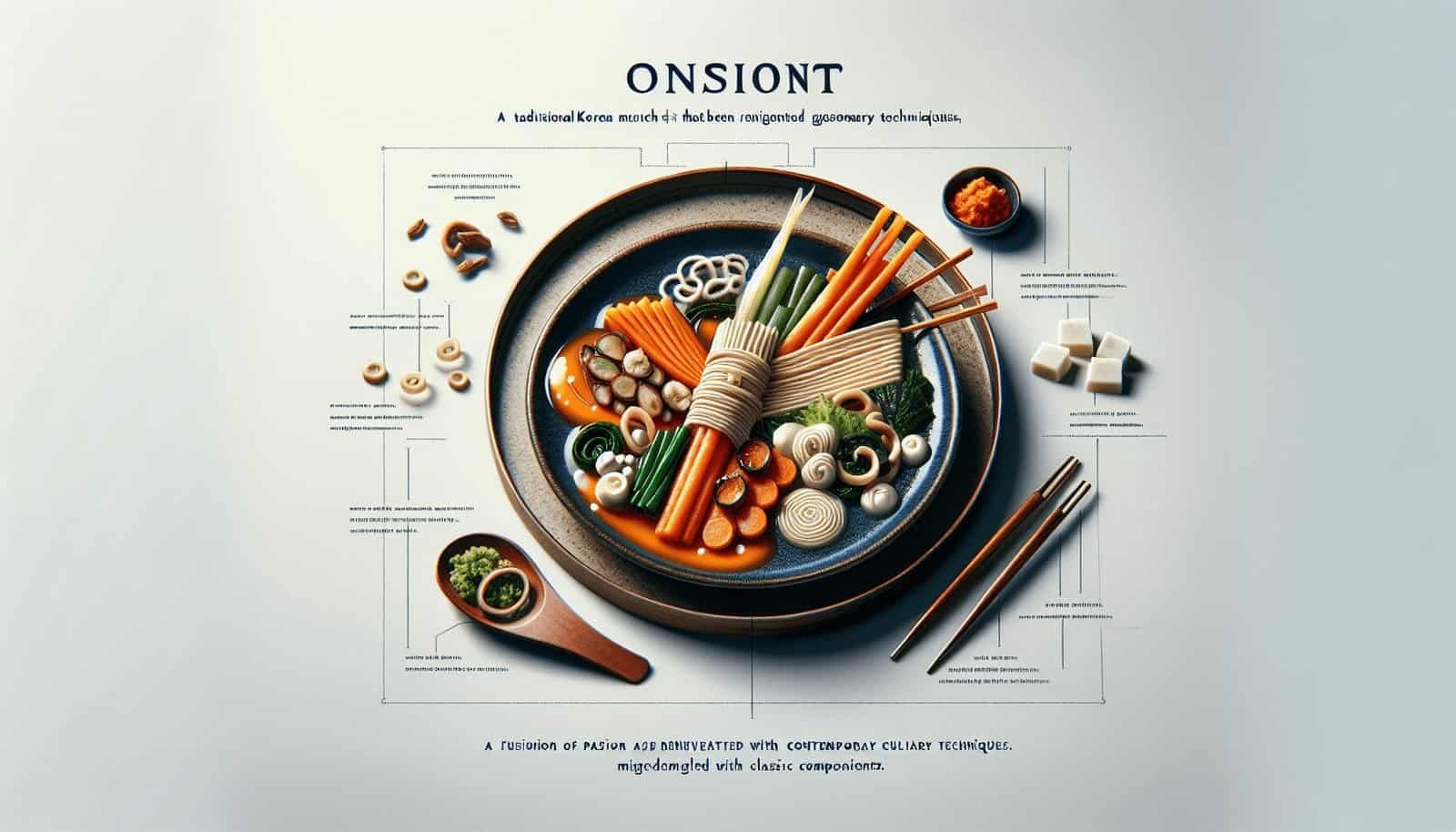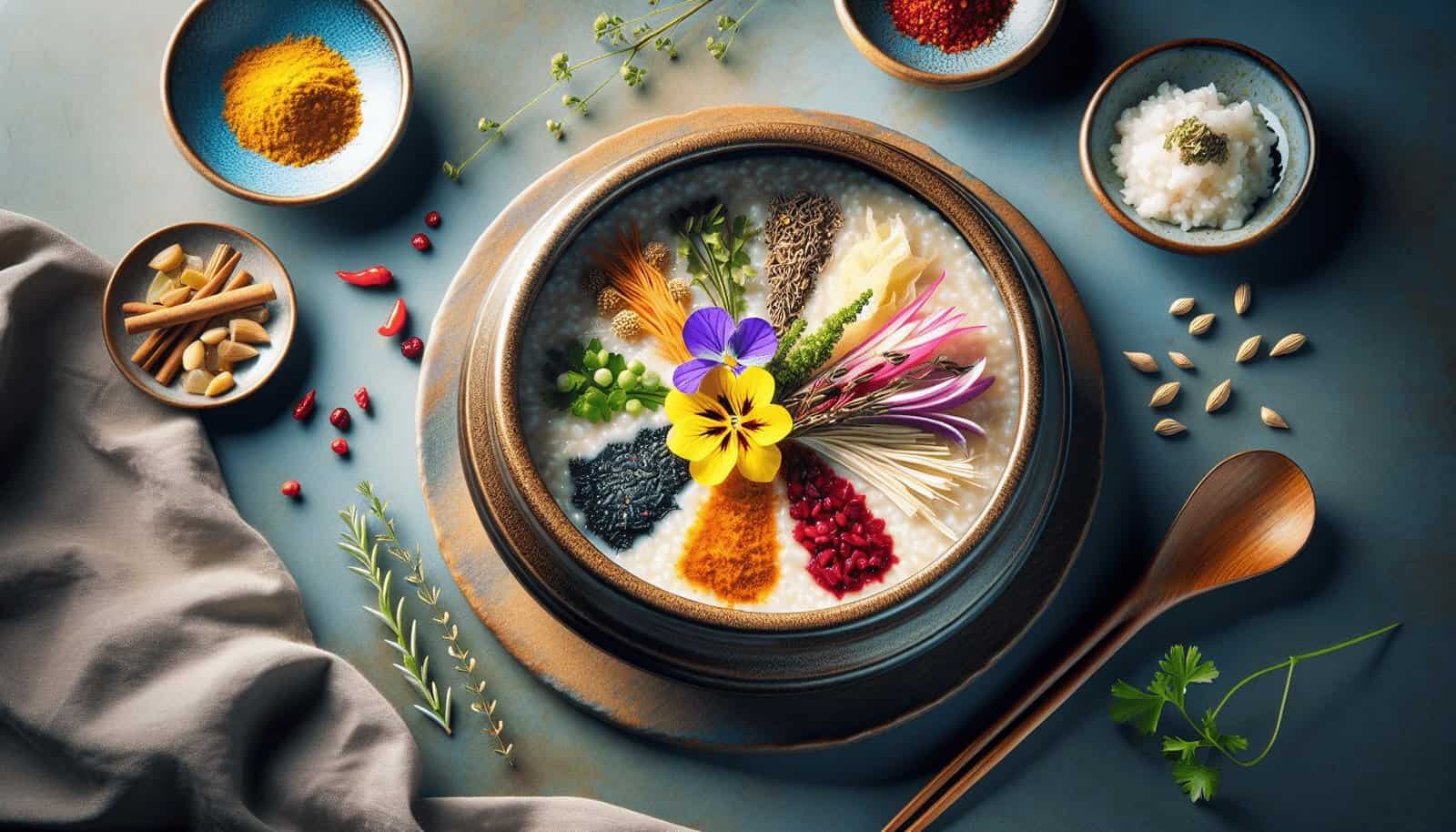Imagine waking up on a cozy morning, craving a warm and comforting breakfast that pays homage to Korean culture. You find yourself yearning for a bowl of traditional Korean porridge, known as juk. But, how can you add a modern twist to this timeless dish? With a touch of creativity and a pinch of innovation, you can effortlessly transform a traditional juk into a modern masterpiece that tantalizes your taste buds. From unexpected flavor combinations to trendy toppings, the possibilities are endless when it comes to infusing a contemporary flair into traditional juk recipes. Get ready to embark on a culinary adventure as we explore the art of adding a modern spin to these beloved Korean porridges.
Exploring New Ingredients
Incorporating exotic fruits
Incorporating exotic fruits into traditional Korean porridges can add a delicious and unexpected twist to familiar flavors. Fruits such as mango, passion fruit, and lychee can bring a burst of tropical sweetness to the porridge. You can either blend the fruits into a puree and add it to the porridge base or garnish the porridge with diced fruit for a refreshing and vibrant presentation.
Using unconventional grains
While traditional Korean porridges are often made with rice or grains such as barley, experimenting with unconventional grains can bring a new dimension to the dish. Quinoa, millet, or even ancient grains like amaranth can be used as a base for the porridge, providing a unique texture and nutty flavor. These alternative grains also offer added nutritional benefits, making your porridge both delicious and healthy.
Adding herbs and spices
To elevate the flavors of traditional Korean porridges, incorporating herbs and spices can make a world of difference. Consider adding fragrant herbs like basil or cilantro to give the porridge a fresh and vibrant taste. Spices such as cinnamon, cardamom, or even turmeric can add warmth and complexity. Experiment with different combinations to find the perfect balance that suits your taste buds.
Creating Unique Toppings
Experimenting with crispy textures
Adding crispy textures to your traditional Korean porridges can create a delightful contrast to the smooth and creamy base. Consider topping your porridge with toasted nuts, fried shallots, or even crispy fried seaweed. These crunchy elements not only add texture but also provide a satisfying bite that complements the porridge perfectly.
Introducing contrasting flavors
Adding toppings with contrasting flavors can take your porridge to a whole new level. For example, if your porridge has a mild and subtle flavor, try topping it with tangy pickles or zesty citrus zest to create a delicious contrast. You can also experiment with sweet and savory combinations, such as pairing a savory porridge with a drizzle of honey or a sprinkle of caramelized onions.
Using colorful garnishes
Don’t overlook the power of visual appeal when it comes to creating unique toppings for your porridge. Consider adding colorful garnishes such as microgreens, edible flowers, or even vibrant fruits and vegetables to make your porridge visually enticing. These pops of color not only make your dish more appealing but also add an extra layer of flavor and freshness.

Playing with Presentation
Using stylish bowls and dishes
The presentation of your porridge can make a significant impact on the overall dining experience. Opt for stylish bowls and dishes that are aesthetically pleasing and complement the colors and textures of the porridge. Consider using ceramic bowls with intricate designs or modern glassware to showcase your creation in the best possible light.
Arranging ingredients artistically
Take the time to arrange the ingredients in your porridge artistically. Whether it’s arranging the toppings in a visually pleasing pattern or creating layers of different colors and textures, the presentation can truly elevate the dining experience. Use your creativity to turn your porridge into a work of art that is both delicious and visually stunning.
Adding a pop of color
Adding a pop of color to your presentation can make your porridge visually enticing. Consider adding vibrant ingredients such as pomegranate seeds, diced bell peppers, or even a sprinkle of turmeric to bring a burst of color to the dish. These colorful accents not only make your porridge more visually appealing but also add depth and dimension to the overall flavor profile.
Incorporating Fusion Techniques
Blending Korean and Western flavors
Fusing Korean and Western flavors can create an exciting and unique twist on traditional Korean porridges. Consider incorporating ingredients such as cheese, bacon, or even truffle oil to add a touch of Western influence. These unexpected flavors can bring a modern flair to the porridge while still honoring its traditional roots.
Infusing international cooking styles
Drawing inspiration from international cooking styles can bring a world of flavors to your traditional Korean porridges. For example, you can infuse Thai flavors by adding lemongrass, coconut milk, or lime zest to your porridge. Alternatively, you could experiment with Indian spices like cumin, coriander, and garam masala to create a fusion of Indian and Korean flavors.
Adopting molecular gastronomy elements
Incorporating molecular gastronomy techniques into your porridge can create a truly unique and modern dining experience. You can experiment with techniques such as spherification to create flavor-filled pearls that burst in your mouth or use liquid nitrogen to create a frozen porridge dessert. These innovative techniques can elevate traditional Korean porridges to a whole new level of culinary creativity.

Experimenting with Textures
Adding crunchy toppings
Textural contrast is key when experimenting with traditional Korean porridges. Add crunchy toppings such as crushed nuts, toasted seeds, or crispy fried garlic to provide a satisfying crunch. Not only do these toppings enhance the overall experience, but they also add an appealing texture that complements the creaminess of the porridge.
Creating smooth and creamy bases
While traditional Korean porridges are naturally smooth and creamy, you can take it a step further by experimenting with different bases. Consider using ingredients like coconut milk, almond milk, or even cashew cream to create a luscious and velvety texture. These alternative bases can add richness and depth to the porridge, making it even more indulgent.
Incorporating chewy ingredients
Introducing chewy ingredients to your porridge can add an interesting textural element. For example, you can add chewy dried fruits like raisins or cranberries, or even experiment with sticky rice cakes or mochi. The combination of the smooth porridge base and the chewy ingredients creates a delightful contrast that keeps your taste buds engaged.
Enhancing Flavors
Balancing sweet and savory notes
Balancing sweet and savory notes is essential in creating flavorful traditional Korean porridges. Experiment with adding a touch of sweetness with ingredients like honey, maple syrup, or even dried fruits. At the same time, incorporate savory elements like soy sauce, miso, or even roasted garlic to create a well-rounded flavor profile that tantalizes the taste buds.
Exploring umami-rich ingredients
Umami, the fifth taste, can be a game-changer when it comes to enhancing the flavors of traditional Korean porridges. Incorporate umami-rich ingredients like mushrooms, seaweed, or fermented soybean paste (doenjang) to add a depth of flavor that leaves a lasting impression. These ingredients elevate the porridge to new heights and create a more satisfying eating experience.
Incorporating tangy and spicy elements
Adding tangy and spicy elements to your porridge can awaken the taste buds and create a harmonious balance of flavors. Experiment with ingredients like kimchi, pickled radishes, or even a squeeze of fresh lemon juice to bring a tangy twist. For those who enjoy a bit of heat, don’t be afraid to incorporate spicy ingredients like chili flakes, gochujang, or even a dash of hot sauce.

Adding Decorative Touches
Utilizing edible flowers
Edible flowers not only add a touch of elegance to your traditional Korean porridges but also contribute to the overall dining experience. Choose flowers such as pansies, nasturtiums, or marigolds that are safe to eat and offer a burst of color and delicate floral notes. These decorative touches make your porridge visually appealing and transport you to a culinary paradise.
Using edible food dyes
Experimenting with edible food dyes can take the presentation of your porridge to the next level. Use natural food dyes like beet juice, turmeric, or even matcha powder to add vibrant hues to the dish. Whether you opt for a bright pink swirl or a vibrant green accent, these food dyes add visual interest and create a whimsical dining experience.
Creating intricate garnishes
Take your porridge presentation to new heights by creating intricate garnishes. Consider using tools like vegetable peelers or microplanes to create delicate curls or zests from fruits and vegetables. Alternatively, you could try your hand at vegetable carving to add intricate patterns and designs to your dish. These attention to detail creates a visually stunning masterpiece that is sure to impress.
Trying Unconventional Pairings
Combining juk with seafood
Combining traditional Korean porridges with seafood can create a delightful fusion of flavors. Experiment with adding ingredients such as shrimp, scallops, or even fish sauce to enhance the umami and oceanic notes. The marriage of the delicate flavors of seafood with the comforting texture of porridge delivers a culinary experience that is both unique and satisfying.
Pairing juk with cheese
Pairing traditional Korean porridges with cheese may seem unconventional, but the combination of creamy porridge and melty cheese can be surprisingly delicious. Opt for mild cheeses like mozzarella or gouda that complement the flavors without overwhelming them. Whether melted on top as a garnish or stirred into the porridge to create a silky texture, cheese adds a touch of indulgence to the dish.
Exploring vegetarian juk options
Traditional Korean porridges often contain meat or seafood, but exploring vegetarian options can broaden your culinary horizons. Incorporate a variety of vegetables such as mushrooms, spinach, or carrots to add depth and texture to the porridge. You can also experiment with plant-based proteins like tofu or tempeh to create a filling and satisfying vegetarian juk. These meat-free options are not only delicious but also cater to a wider range of dietary preferences.

Experimenting with Cooking Techniques
Slow cooking for enhanced flavors
Slow cooking traditional Korean porridges allows the flavors to meld together and intensify. By simmering the porridge on low heat for an extended period, you achieve a rich and flavorful base. The slow cooking process also allows the ingredients to break down, creating a silky and creamy texture that is incredibly indulgent. Patience is the key to unlocking the depths of flavor in a slow-cooked porridge.
Pressure cooking for efficient preparation
If time is of the essence, pressure cooking can be a game-changer when preparing traditional Korean porridges. Pressure cooking reduces the cooking time significantly while still infusing the flavors into the dish. The high pressure forces the flavors to penetrate deep into the ingredients, resulting in a robust and well-rounded flavor profile. Pressure cooking not only saves time but also ensures a perfectly cooked and flavorful porridge every time.
Grilling or broiling for smoky undertones
Adding smoky undertones to your traditional Korean porridges can bring a whole new level of complexity to the dish. Consider grilling or broiling ingredients such as garlic, onions, or mushrooms before adding them to the porridge. The smoky flavors enhance the overall taste and add a subtle depth that elevates the porridge to a smoldering sensation.
Getting Inspired by Regional Variations
Exploring different juk recipes from Korean provinces
Each Korean province offers its unique take on traditional porridges (juk), providing a wealth of inspiration. Explore the flavors and ingredients used in regional juk recipes to create your own modern twist. Whether it’s the seafood-rich porridges of the coastal provinces or the hearty and meaty porridges of the mountainous regions, each regional variation offers a glimpse into the diverse culinary landscape of Korea.
Incorporating unique ingredients used in regional juk
To truly capture the essence of regional juk, incorporate unique ingredients that are specific to each province. For example, you could use sea snails or sea squirts in coastal-inspired porridges or wild mushrooms foraged from the mountains in forest-inspired porridges. These regional ingredients not only showcase the local flavors but also add an authentic touch to your modern juk creations.
Adapting cooking techniques from specific regions
In addition to ingredients, adapt cooking techniques used in specific regions to create a modern flair. For example, learn the traditional method of slow-cooking juk from the Jeolla province, known for its expertise in preparing porridges. Alternatively, experiment with grilling techniques inspired by the barbecue-loving Gyeongsang province. By incorporating these regional cooking techniques, you can pay homage to the culinary traditions while adding your own modern twist.
In conclusion, adding a modern flair to traditional Korean porridges (juk) is all about exploring new ingredients, creating unique toppings, playing with presentation, incorporating fusion techniques, experimenting with textures, enhancing flavors, adding decorative touches, trying unconventional pairings, experimenting with cooking techniques, and getting inspired by regional variations. Whether it’s through the incorporation of exotic fruits, the introduction of contrasting flavors, or the utilization of edible flowers, the possibilities for reinventing traditional Korean porridges are endless. Get creative, explore, and have fun in the kitchen as you embark on a culinary journey that celebrates both tradition and innovation.

